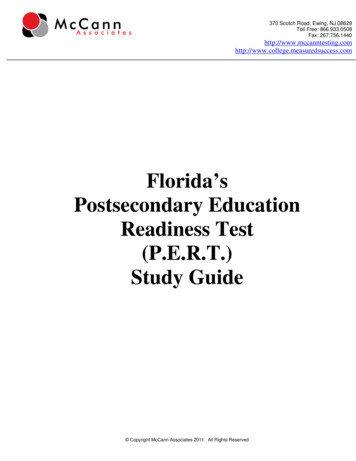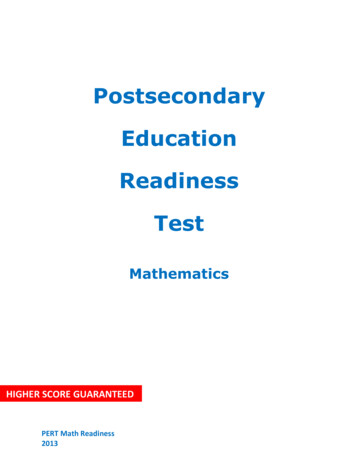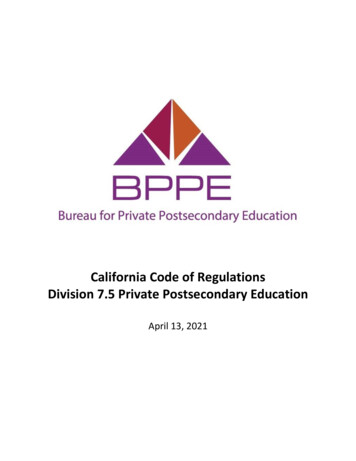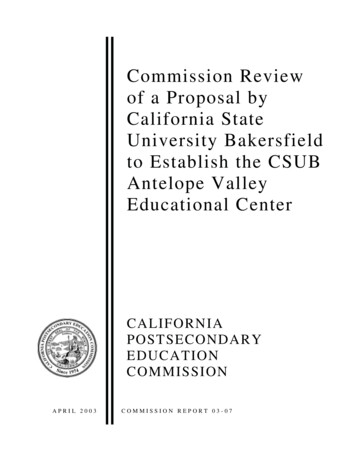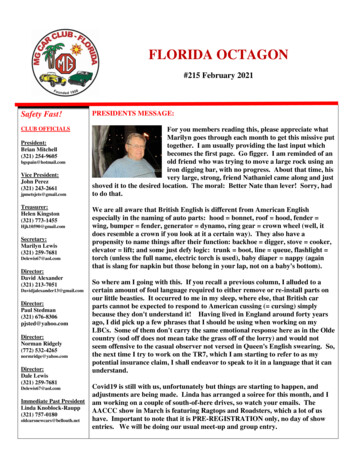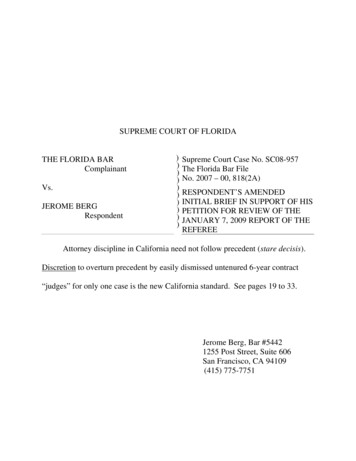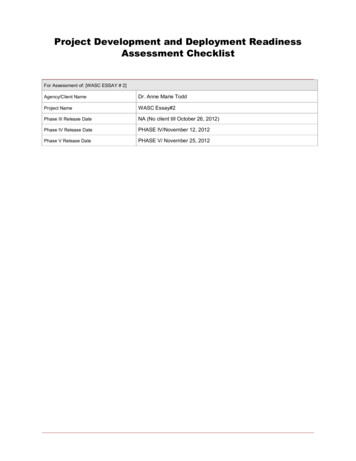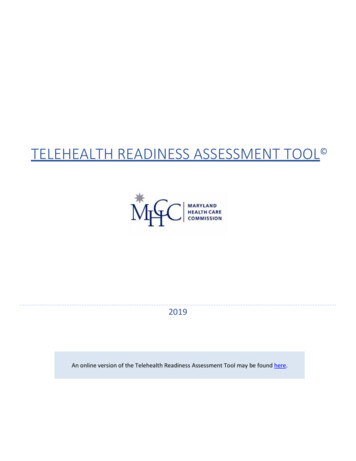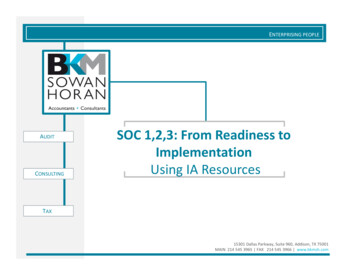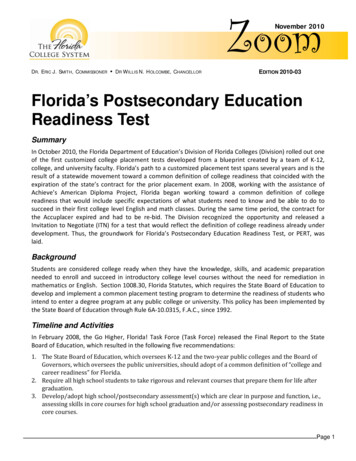
Transcription
ZoomNovember 2010DR. ERIC J. SMITH, COMMISSIONER y DR WILLIS N. HOLCOMBE, CHANCELLOREDITION 2010-03Florida’s Postsecondary EducationReadiness TestSummaryIn October 2010, the Florida Department of Education’s Division of Florida Colleges (Division) rolled out oneof the first customized college placement tests developed from a blueprint created by a team of K‐12,college, and university faculty. Florida’s path to a customized placement test spans several years and is theresult of a statewide movement toward a common definition of college readiness that coincided with theexpiration of the state’s contract for the prior placement exam. In 2008, working with the assistance ofAchieve’s American Diploma Project, Florida began working toward a common definition of collegereadiness that would include specific expectations of what students need to know and be able to do tosucceed in their first college level English and math classes. During the same time period, the contract forthe Accuplacer expired and had to be re‐bid. The Division recognized the opportunity and released aInvitation to Negotiate (ITN) for a test that would reflect the definition of college readiness already underdevelopment. Thus, the groundwork for Florida’s Postsecondary Education Readiness Test, or PERT, waslaid.BackgroundStudents are considered college ready when they have the knowledge, skills, and academic preparationneeded to enroll and succeed in introductory college level courses without the need for remediation inmathematics or English. Section 1008.30, Florida Statutes, which requires the State Board of Education todevelop and implement a common placement testing program to determine the readiness of students whointend to enter a degree program at any public college or university. This policy has been implemented bythe State Board of Education through Rule 6A‐10.0315, F.A.C., since 1992.Timeline and ActivitiesIn February 2008, the Go Higher, Florida! Task Force (Task Force) released the Final Report to the StateBoard of Education, which resulted in the following five recommendations:1. The State Board of Education, which oversees K‐12 and the two‐year public colleges and the Board ofGovernors, which oversees the public universities, should adopt of a common definition of “college andcareer readiness” for Florida.2. Require all high school students to take rigorous and relevant courses that prepare them for life aftergraduation.3. Develop/adopt high school/postsecondary assessment(s) which are clear in purpose and function, i.e.,assessing skills in core courses for high school graduation and/or assessing postsecondary readiness incore courses.Page 1
PERT HISTORYNOVEMBER, EDITION 2010-034. Using FACTS.org and other media avenues, improve public awareness/understanding of current and futureassessments, at all levels, their use as diagnostic tools, and the relationship between these assessments asmeasures of achievement and learning gains. Emphasize/promote system wide, cross‐sector communicationand participation.5. State of Florida should join 30 other states in The American Diploma Project (ADP) initiative.In April 2008, responding to the Task Force recommendations, Governor Charlie Crist, upon the recommendationof the Commissioner of Education, announced Florida’s participation in Achieve’s American Diploma ProjectNetwork. September 2008, as an initial step in aligning high school exit and college entry expectations, the Divisionof Florida Colleges organized a faculty workshop comprised of over 70 cross‐sector English/language arts (ELA) andmathematics (math) faculty, including high school teachers, Florida college and state university faculty. Facultybroke out into subject areas and reviewed the American Diploma Project (ADP) benchmarks identifying thosecompetencies they deemed critical to college readiness in math and English.The process was facilitated by Florida’s Statewide Course Numbering System, a statewide database ofpostsecondary courses that are determined by faculty to be similar in content. Courses designated by a commoncourse number are guaranteed to transfer to any other postsecondary institution offering the same course,ensuring that the entry level college credit courses at all public postsecondary institutions in Florida are the samethroughout the state. ENC 1101, Freshman Composition Skills I, and MAT 1033, Intermediate Algebra, wereidentified as the courses that best represented “the first credit bearing course” in each subject.The faculty at the September workshop were asked to identify the ADP benchmarks that would prepare studentsfor entry to ENC 1101 and MAT 1033. Faculty identified a subset of ADP benchmarks that are necessary forincoming students to be ready without the need for remediation. During the months of September and October2008, surveys were sent to faculty and business and industry representatives to review the benchmarks. Theprocess was heavily collaborative and inclusive with faculty ranking benchmarks in order of importance, businessand industry providing input, and the Department’s Division of Florida Colleges, Division of Public Schools, Divisionof Career and Adult Education, Office of Articulation (PreK‐20) and the Office of the Board of Governors providinginput and oversight. This truly cross‐sector endeavor resulted in the identification of Florida’s PostsecondaryReadiness Competencies (PRCs).Once finalized, the PRCs were aligned with the K‐12 Sunshine State Standards through a cooperative effortbetween the Florida Department of Education (Department) and Achieve. The purpose was to identify anypotential gaps and ensure that the K‐12 curriculum addresses the competencies necessary for college readiness, asdefined by postsecondary faculty.Simultaneously, the Department began developing the Invitation to Negotiate (ITN) for a preferred pricing contractfor the college placement test. The PRCs were the centerpiece of the ITN. Faculty convened in April 2009 to identifyor develop exemplar test items for each PRC. Many of the same faculty involved in this process had previously beeninvolved in the identification of Florida’s Postsecondary Readiness Competencies. These experts chose items thatcovered the breadth and depth of each competency, ensuring that the items chosen were representative of theknowledge that incoming students should possess in order to be successful in entry‐level college credit math andEnglish courses without the need for remediation. The PRCs and exemplars were included in the ITN. Theinstructions for the content portion of the ITN directed vendors to submit sample test items that were aligned withthe PRCs and the exemplars.In addition to customization to Florida’s definition of college readiness, the Department identified two otherimportant requirements for the new placement test; affordability and availability diagnostic capabilities. ForPage 2
PERT HISTORY AND TIMELINENOVEMBER 2010, EDITION 2010-03students who do not meet the state determined cut score, the assessment would need to be able to diagnosedeficiencies on specific PRCs. An additional assessment capability was needed to measure students’ mathematicsproficiency at a level appropriate for placement into MAC 1105, College Algebra, the next course in themathematics sequence after MAT 1033.The Department received three proposals in response to the ITN and the proposal review consisted of threeseparate review committees – a Content Review Team, a Technical Review Team and a Negotiation Team. TheContent Review Team was comprised of many of the same faculty who developed the exemplars. The ContentReview Team was provided with the vendor’s sample items and, using the rating criteria, reviewed the itemalignment with the PRCs and item quality. After a rigorous review and a unanimous decision by the NegotiatingTeam, the notice of award was posted in January 2010, and McCann Associates (McCann) was selected as Florida’snext preferred placement test vendor.In April 2010, the Department moved to revise the Postsecondary Readiness Competencies to better align with thenational Common Core State Standards. Florida Department of Education Commissioner, Dr. Eric Smith, publiclysupported the efforts led by the National Governors Association Center for Best Practices and the Council of ChiefState School Officers to develop a set of national K‐12 standards. The Department engaged a core team of facultyto review the PRCs and the draft Common Core College and Career Readiness Standards. In addition, facultyreviewed the current skills included in Florida’s Basic Skills Exit Test, the test administered to students at the end ofthe highest level of developmental education. In order to progress to college credit coursework in a given subject,students must meet local cut scores on the Basic Skills Exit Test. This work resulted in a revised set of PRCs whichare a subset of the previously identified ADP benchmarks, draft Common Core College and Career ReadinessStandards and Basic Skills Exit Test competencies. The revised PRCs were then used to begin test itemdevelopment.Once the test items were ready, they required pilot testing. In June 2010, Florida’s colleges administered over10,000 PERT pilot exams. The data from the pilot was then used to build the PERT item bank. The faculty team wasre‐convened in August 2010 in Tallahassee to review the entire item bank. The team analyzed each potential itemfor alignment with the PRCs and overall quality and made recommendations for adjustments.Following the August faculty review, it was determined that there were not enough operational items approved bythe faculty to launch a computer‐adaptive test (CAT) in all three areas – reading, writing, and math. Afterconsidering a proposal from McCann, the Department decided to move forward with a linear test with 25operational items and 5 field test items for reading and math while writing would start as a CAT. Once the numberof administrations provides sufficient data, the field test items will be either removed from the bank or moved tothe operational item pool. When the operational item pool is large enough to support CAT, McCann will seamlesslytransition to computer‐adaptive tests in mathematics and reading. Because of the critical role faculty played inPERT item development, the Department and McCann established an ongoing process to ensure faculty drive thedevelopment of new PERT items, thereby ensuring not only the quality of the items but increasing acceptance ofthe test by faculty and administrators.The Department worked directly with McCann psychometricians to develop interim cut scores for placement intolower and upper developmental education, entry‐level college credit, and MAC 1105. The strategy for interim cutscores was to place students into these courses in similar proportions to the current placement rate to avoiddramatic changes in course enrollment and faculty assignments. Each college is expected to use the interim cutscores for placement purposes until the Department has enough PERT performance and course outcome data toset final cut scores in State Board rule. It is anticipated that it will take close to a year to obtain the necessary data.Page 3
PERT HISTORY AND TIMELINENOVEMBER 2010, EDITION 2010-03The Department is now working with the colleges to restructure the developmental education course sequence.The goal is to align course numbers and establish equivalent courses statewide. By standardizing the coursenumbers across colleges, the Department will be able to effectively establish statewide cut scores for lower andupper developmental education courses. Without such standardization, common cut scores below entry‐levelcollege credit would not be possible.October 25, 2010 the PERT went live. During the initial rollout phase, faculty at each college will be given theopportunity to take the PERT in a proctored setting. Each college is now in the process of transitioning from theAccuplacer to the PERT. By the end of spring 2011, every college in Florida is expected to use the PERT as theirprimary placement tool. Also in early 2011, it is anticipated that the diagnostic capabilities of the PERT system willbe ready and colleges will have the ability to identify specific competencies students need to master in order to beready for college level coursework. This will enable colleges to tailor instruction and reduce the time needed forremediation while enhancing the probability of success.In the coming year, the Division of Florida Colleges and the Division of Public Schools will explore the feasibility ofauthorizing high schools to administer the PERT. While the high schools are well on their way to developing thecapacity to administer computer‐based tests to each student, procedures will need to be developed to ensure thatthe same standards for test security and administration adhered to by the colleges are in place for high schools. Inaddition, the Department and McCann are working with the US Department of Education to determine the processfor the PERT to become authorized as an ability‐to‐benefit assessment for federal financial aid eligibility purposes.Page 4
PERT HISTORY AND TIMELINENOVEMBER 2010, EDITION 2010-03Appendix A:A Guide to Developing a Customized Placement TestFor states interested in customizing placement assessments, consider the following step‐by‐step guide to assistwith the process.1. Develop a core team of cross‐sector state level administrators to coordinate the activities.2. Identify a cross‐sector team of faculty that are willing and able to participate in an ongoing effort for two ormore years.3. Have faculty identify competencies and expectations for developmental courses through the first level ofcollege credit courses. Note: ADP and Common Core (and others) may be used as references but faculty shouldnot be constrained. Allow faculty to develop their own competencies that match their expectations of enteringstudents.4. Have
instructions for the content portion of the ITN directed vendors to submit sample test items that were aligned with the PRCs and the exemplars. In addition to customization to Florida’s definition of college readiness, the Department identified two other important requirements for the new placement test; affordability and availability diagnostic capabilities. For Page 2 . PERT HISTORY AND .
